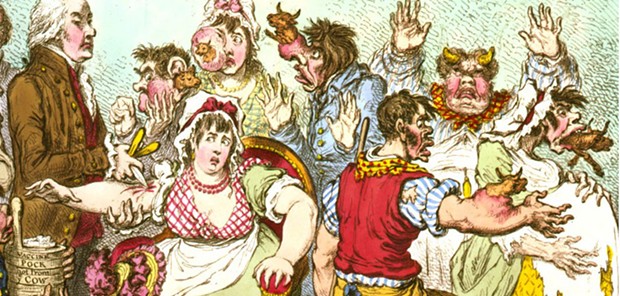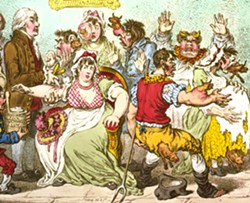[
{
"name": "Top Stories Video Pair",
"insertPoint": "7",
"component": "17087298",
"parentWrapperClass": "fdn-ads-inline-content-block",
"requiredCountToDisplay": "1"
}
]
"Every year, thousands undergo this operation, and the French Ambassador says pleasantly, that they take the small-pox here by way of diversion, as they take the waters in other countries." — From a 1717 letter from Mary Wortley Montagu, wife of the British Ambassador to Turkey
Lady Montagu was writing from Adrianople (modern Erdine) in western Turkey about the annual practice there of variolation, the inoculation of healthy children with a weak strain of smallpox to confer future immunity from the real thing in later life. Having barely survived smallpox two years earlier, while her brother died of it, Montagu became an enthusiastic advocate of the practice on her return to Britain. Over the next 30 years, some 400,000 people in Britain were "variolated," leading to a marked decrease in smallpox deaths. Variolation, which the Chinese had already been practicing for hundreds of years, was the first attempt to induce immunity before a disease struck.
Variolation led to vaccination. Unlike variolation, which introduces live smallpox viruses into a body (with a 1 to 3 percent risk of death), vaccination uses weakened or killed germs that cannot cause serious illness. For instance, in vaccination's first and greatest success story, smallpox was countered with cowpox, a weak form of smallpox, which is non-fatal to humans. The well-known story of how an English country doctor, Edward Jenner, discovered vaccination is worth repeating here.
As Jenner (who wasn't above a touch of self-mythologizing) told it, he heard a milkmaid boast that her face would never be pockmarked by smallpox because she'd already had cowpox. Jenner hypothesized that the girl's cowpox had given her immunity to smallpox, so, in 1796, he deliberately infected the 8-year-old son of his gardener with cowpox using lymph fluid from a cowpox sufferer. Six weeks later, he tried to infect the kid with smallpox (no medical ethics boards back then). The boy remained healthy, Jenner successfully repeated the experiment on a dozen more children and the science of vaccination (from the Latin vacca, meaning cow) was born.
Nearly 200 years later, in 1980, the World Health Organization announced that smallpox had been totally eradicated. It's hard to exaggerate this accomplishment. In Jenner's day, an average of 400,000 Europeans died — horribly and painfully — every year from the disease. When epidemics struck, which they did regularly, up to a third of the populations of entire countries died. Survivors were left pockmarked for life.
Modern vaccines now target a host of other potentially crippling and fatal diseases including polio, measles, rubella, diphtheria and tetanus (all of which have been eliminated from the U.S.), hepatitis A and B, chickenpox and mumps. Consider that in the pre-vaccine era, almost every family routinely lost a child to one of these diseases; today, childhood death from disease is so rare that it's now thought of as an unexpected tragedy.
Following Jenner's discovery, governments implemented compulsory vaccination programs to protect not just individuals, but whole populations. With enough people inoculated (85 to 95 percent), disease-causing viruses are denied hosts, essentially stopping epidemics in their tracks. (The unfortunate term for this is "herd immunity.") "Anti-vaxxers" in the 19th and 20th centuries objected on much the same libertarian, religious, philosophical and suspicious-of-science grounds as they do today. In the U.S., after decades of resistance in the late 1800s, the U.S. Supreme Court ruled in favor of compulsory vaccination, citing "manifold restraints to which every person is necessarily subject for the common good." That was in 1905, and it's still pretty much the law of the land that public health considerations override personal liberty. To put it bluntly, when the exercise of your rights puts other people at risk, you lose those rights.
Barry Evans ([email protected]), who grew up at a time when polio was greatly feared, considers Jonas Salk and Albert Sabin (developers of polio vaccines) his heroes.
Comments
Showing 1-1 of 1
Comments are closed.
more from the author
-
A Brief History of Dildos
- Apr 11, 2024
-
Eclipse!
- Mar 28, 2024
-
The Little Drone that Could
- Mar 14, 2024
- More »
Latest in Field Notes
Readers also liked…
-
Trouble on the Line: The Reality Part 2
- Nov 3, 2022


































